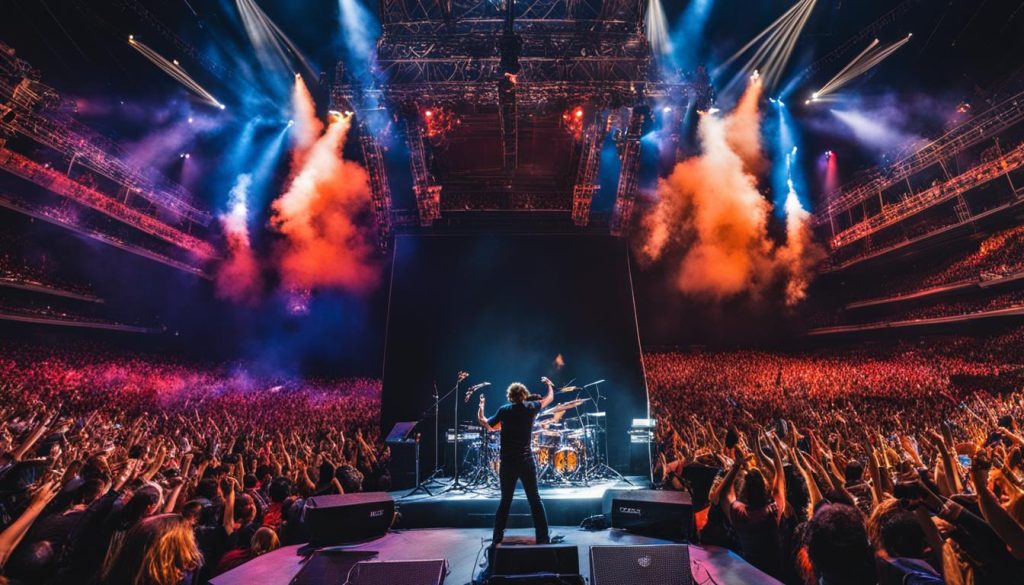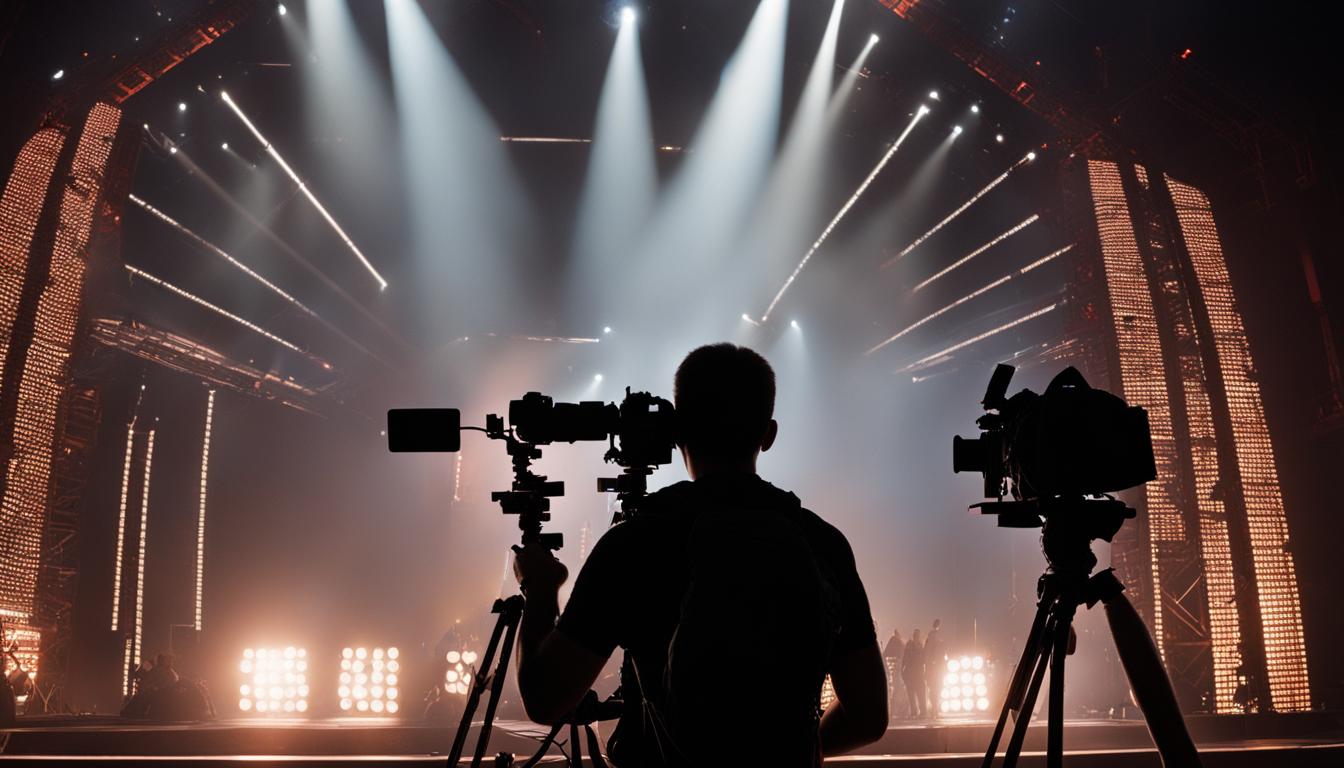Concert photography is an exhilarating experience that requires both technical knowledge and creativity. Capturing the perfect shot in a live music performance takes preparation, attention to detail, and a little bit of luck. But, with the right tools and techniques, anyone can take amazing concert photos. In this section, we’ll provide you with an essential Concert Photography Checklist, a guide to prepare you for everything you need to know before attending concerts to make the most of your concert photography experience.
Key Takeaways
- An organized concert photography checklist can help you capture epic shots during live music performances.
- Researching the concert venue, artist, and performance before attending the concert can give you an idea of what to expect.
- Packing your essential gear, understanding lighting conditions and nailing the composition can make a huge difference in your concert photography.
- Capturing stunning shots during high-action moments can be done through anticipating the action and freeze motion.
- Lastly, post-processing and editing your concert photos are the final touch to take your photographs to the next level.
Research the Venue and Artist
Before attending a concert, conducting thorough research on the concert venue and artist is crucial for ensuring a successful concert photography experience. It is important to familiarize oneself with the layout of the concert venue, including its lighting conditions and any restrictions on photography. Additionally, gathering information about the artist’s performance style, songs, and anticipated moments that one should be ready to capture will help to produce stunning photographs.
To achieve this, visit the concert venue website and social media platforms to gather as much information as possible. One can also listen to the artist’s music and watch past concerts to gain insights. By doing this, one can come up with certain elements that they would like to capture and focus on during the concert.
Concert Venue Research Checklist:
- Location and how to get there
- Layout of the venue
- Lighting conditions
- Restricted areas
- Accessible areas
Artist Research Checklist:
- Performance style
- Setlist
- Audience interaction
- Outfit
- Expected special effects
By researching the concert venue and artist carefully beforehand, one can be fully prepared and more confident to capture epic shots during the concert.
Preparing Your Gear
Concert photography requires a range of essential gear to capture amazing shots. Ensure that you have all the necessary equipment to make the most of your experience.
Check Your Camera
Before attending a concert, ensure that your camera is in good working order. Check the battery life, memory card space and test the camera to ensure it can capture high-quality photos.
Bring a Variety of Lenses
Concerts offer a wide range of opportunities for capturing unique and dynamic shots. To capture the best possible photos, bring a variety of lenses for different perspectives and focal lengths. Wide-angle lenses are great for capturing the essence of the stage and the crowd, while telephoto lenses allow for more intimate close-ups of the artists.
Don’t Forget Extra Batteries and Memory Cards
Concert photography can be demanding on both your camera and equipment, make sure you have extra batteries and memory cards to avoid missing out on important moments. Additionally, shooting in RAW formats require more space, so ensure you have enough memory storage space available.
Sturdy Tripod
Concerts often present low light conditions, making it challenging to capture sharp images without causing unwanted blur. A sturdy tripod will provide stability and help you achieve steady, sharp shots, even in low light situations.
Understanding Lighting Conditions
When it comes to concert photography, lighting conditions can be a real challenge. With constantly changing lights, it’s essential to know how to make the most out of the stage lighting to get the best shots.
Understanding the exposure triangle of aperture, shutter speed, and ISO is crucial in low light settings. Adjusting your settings for each shot can help you capture the energy, mood, and atmosphere of the performance.
Experiment with different settings and find the right balance between exposure and noise to produce high-quality images. In challenging situations, shooting in RAW format can offer more flexibility during post-processing.
Beware of overexposure or underexposure that can ruin a shot, and make sure to keep an eye on the histogram for a well-exposed image.
Nailing the Composition
When it comes to concert photography, composition can make or break your shot. By experimenting with different framing techniques and angles, you can capture the energy and emotion of the performance.
One technique that can help you create a balanced and visually appealing composition is the rule of thirds. This involves dividing your frame into thirds both horizontally and vertically, and placing your subject at one of the intersecting points. Doing so creates a sense of tension and balance within your photograph.
Another technique to keep in mind is framing. Use elements within the concert venue or landscape to frame your subject and draw the viewer’s eye towards the main focal point of the photograph. This could be the stage lights, microphone stands, or even the fans in the crowd.
Don’t forget to look for opportunities to capture the emotions of the performance. When photographing band members, try to capture their unique personalities and interactions. Likewise, keep an eye on the artist’s face for expressions that tell a compelling story.
Remember, the goal is to tell a story through your photographs. By utilizing these techniques, you can capture epic shots that transport viewers to the energy and excitement of the live performance.
Capturing the Action
Concerts are all about movement and action. To capture the energy of the moment, you need to use a fast shutter speed to freeze motion and avoid blur. Don’t be afraid to experiment with different settings to get the perfect shot. Anticipate key moments such as guitar solos, jumps, or crowd interactions to capture those epic shots.
Move around the venue to capture different perspectives and angles. This will give you a variety of shots to choose from and ensure that you don’t miss any important moments. Keep an eye out for unique shots of musicians in action, dancing fans, or close-ups of instruments.
Use the freeze motion technique to capture the movement of musicians or fans during an energetic performance. This will capture the moment and showcase the artists’ passion for music.
Anticipating Moments
Anticipating key moments is key when capturing action shots at concerts. Moments such as a lead singer’s dramatic pause, a drummer’s crescendo, or a guitar solo can become iconic moments with the click of a shutter. Study the performers’ sets to familiarize yourself with these moments ahead of time and be ready to capture them in all their glory. Anticipation is the key to getting the shot right.
Post-Processing and Editing
After capturing epic shots of the performance, the next step is to enhance them through post-processing and editing. By shooting in RAW format, you have more flexibility during the editing process to adjust exposure, contrast, and color balance. RAW files retain more information than JPEGs, making it easier to recover details and fix issues that may have occurred during the shoot.
Use editing software such as Adobe Lightroom, Capture One, or Luminar AI to edit your concert photos. Start by adjusting the exposure of your shots, then move on to color correction and saturation adjustments. Experiment with different editing styles and presets to create a unique and captivating look for your concert photos.
Don’t be afraid to enhance details with sharpening or noise reduction tools in your software. Remember, you want your concert photos to be sharp and free from noise, so be sure not to overdo it.

In conclusion, post-processing and editing your concert photos can truly bring out the best in your shots by fine-tuning them to perfection. With RAW files and some basic editing knowledge, your concert photos can become a true work of art.
Conclusion
As a concert photographer, you have the opportunity to capture some of the most electrifying moments in live music history. With the help of this essential concert photography checklist, you can ensure that you’re well-prepared to capture epic shots of your favorite artists and bands.
Remember, research the venue and artist, prepare your gear, understand lighting conditions, nail the composition, and capture the action. Post-processing and editing will further enhance your photos, leaving you with cherished memories of your experience.
So, whether you’re a seasoned pro or a beginner, follow this checklist, and you’ll be on your way to taking unforgettable concert photos. Keep practicing and experimenting, and you’ll be amazed at the incredible shots you’ll capture.






